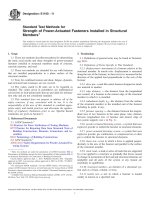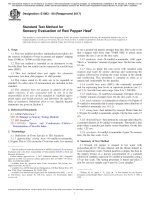Astm e 1188 11 (2017)
Bạn đang xem bản rút gọn của tài liệu. Xem và tải ngay bản đầy đủ của tài liệu tại đây (63.95 KB, 2 trang )
This international standard was developed in accordance with internationally recognized principles on standardization established in the Decision on Principles for the
Development of International Standards, Guides and Recommendations issued by the World Trade Organization Technical Barriers to Trade (TBT) Committee.
Designation: E1188 − 11 (Reapproved 2017)
Standard Practice for
Collection and Preservation of Information and Physical
Items by a Technical Investigator1
This standard is issued under the fixed designation E1188; the number immediately following the designation indicates the year of
original adoption or, in the case of revision, the year of last revision. A number in parentheses indicates the year of last reapproval. A
superscript epsilon (´) indicates an editorial change since the last revision or reapproval.
2.2 The quality of evidence may change with time,
therefore, special effort should be taken to capture and preserve
evidence in an expeditious manner. This practice sets forth
guidelines for the collection and preservation of evidence for
further analysis.
1. Scope
1.1 This practice covers guidelines for the collection and
preservation of information and physical items by any technical investigator pertaining to an incident that can be reasonably
expected to be the subject of litigation.
1.2 This practice recommends generally accepted professional principles and operations, although the facts and issues
of each situation require consideration, and frequently involve
matters not expressly dealt with herein. Deviations from this
practice should be based on specific articulable circumstances.
2.3 Evidence that has been collected and preserved shall be
identified with, and be traceable to, the incident. This practice
sets forth guidelines for such procedures.
1.3 This practice offers a set of instructions for performing
one or more specific operations. This standard cannot replace
knowledge, skill or ability acquired through appropriate
education, training, and experience and should be used in
conjunction with sound professional judgment.
1.4 This standard does not purport to address all of the
safety concerns, if any, associated with its use. It is the
responsibility of the user of this standard to establish appropriate safety and health practices and determine the applicability of regulatory limitations prior to use.
1.5 This international standard was developed in accordance with internationally recognized principles on standardization established in the Decision on Principles for the
Development of International Standards, Guides and Recommendations issued by the World Trade Organization Technical
Barriers to Trade (TBT) Committee.
3.1 Documentary Information—Collect information related
to events and conditions occurring before, during, or after the
incident. Documentary information may be held by any entity
associated with the incident. Make a broad search to identify
documents and, where possible, collect them. Obtain statements as early as feasible from all individuals associated with
the incident and the recovery activity.
3. Procedure
3.2 Physical Evidence:
3.2.1 Plan the investigation to protect physical evidence
significant to the incident. The plan should consider the
possibility of identity loss, physical loss, or the deterioration or
destruction of information due to environmental effects or the
recovery and collection activities. For each item considered to
be significant to the incident, document, collect and preserve
physical items and their information content as soon as
possible.
3.2.2 Document conditions that prevent or interfere with the
preservation of any potential evidence in the state in which it
was found. This might include hazardous or accessibility
conditions, weather conditions, or other existing complications.
3.2.3 Assign a unique identifier to each item collected and
include this information in a label securely attached to the item
or as documentation on the item’s container and enter the
identifying information on a log sheet together with a brief
description of the item. The evidence documentation should
also clearly include any specific details necessary for preservation of the item, such as temperature control or special
handling instructions.
2. Significance and Use
2.1 This practice is intended for use by any technical
investigator when investigating an incident that can be reasonably expected to be the subject of litigation. The intent is to
obtain sufficient information and physical items to discover
evidence associated with the incident and to preserve it for
analysis.
1
This practice is under the jurisdiction of ASTM Committee E30 on Forensic
Sciences and is the direct responsibility of Subcommittee E30.11 on Interdisciplinary Forensic Science Standards.
Current edition approved March 15, 2017. Published March 2017. Originally
approved in 1987. Last previous edition approved in 2011 as E1188 – 11. DOI:
10.1520/E1188-11R17.
Copyright © ASTM International, 100 Barr Harbor Drive, PO Box C700, West Conshohocken, PA 19428-2959. United States
1
E1188 − 11 (2017)
3.4.1.2 Location where the evidence was found,
3.4.1.3 Date and time the evidence was found or obtained,
and
3.4.1.4 Name and affiliation of the individual who initially
removed the evidence from the incident scene.
3.4.2 Subsequent Custody Transfer Information—
Contemporaneous documentation of the following
(information/documentation may not be available all in the
same location):
3.4.2.1 Name and affiliation of each subsequent custodian
along with the date of transfer.
3.4.2.2 Modification or repackaging of items by each
custodian, and
3.4.2.3 Configuration and condition when transferred to the
new custodian.
3.3 Photographic Documentation:
3.3.1 Commence photographic documentation as soon as
possible after the incident. Document the scene of the incident
and the condition of items involved.
3.3.2 Potential evidence should be photographed in the
position where it is first observed by the investigator. If items
involved in the incident are disassembled or subjected to
destructive testing, each step of the disassembly or testing shall
be documented by contemporaneous photographs or videotaping.
3.3.3 The photographic technique utilized should be of
sufficient resolution to preserve the essential aspects of the
appearance of the evidence being photographed, and should
also be capable of producing images that can be reproduced
and enlarged. The date, time, and location of the photography
or videotaping, and the identity of the photographer or videotaper shall be documented.
3.5 It is preferred that evidence and documentation should
remain unchanged to the fullest extent possible.
3.5.1 If transfer of information or items to a more appropriate storage medium is necessary, this is permitted provided that
information loss is minimized.
3.5.2 If an agency or company has a written document or
evidence retention policy, that policy should be followed.
These types of policies are routinely found when dealing with
evidence that is potentially hazardous or present in large
volumes.
3.4 Validation and Authentication—To support the admissibility of evidence and information, the validity and authenticity
must be established and the chain of custody traceable. Validity
and authenticity of evidence is established by documentation
that defines the relationship of the evidence to the incident.
Parts of this documentation may be located within the records
of different agencies; however, it is the intention of this
practice that the history of custody should be capable of being
reconstructed to reflect the entire lifetime of the evidence. Such
documentation includes, but is not limited to, the following:
3.4.1 Initial Collection Information—Document the following:
3.4.1.1 Identity of the evidence and any unique labeling,
4. Keywords
4.1 evidence collection; evidence documentation; forensic
engineers; forensic sciences; photographic documentation;
technical investigator
ASTM International takes no position respecting the validity of any patent rights asserted in connection with any item mentioned
in this standard. Users of this standard are expressly advised that determination of the validity of any such patent rights, and the risk
of infringement of such rights, are entirely their own responsibility.
This standard is subject to revision at any time by the responsible technical committee and must be reviewed every five years and
if not revised, either reapproved or withdrawn. Your comments are invited either for revision of this standard or for additional standards
and should be addressed to ASTM International Headquarters. Your comments will receive careful consideration at a meeting of the
responsible technical committee, which you may attend. If you feel that your comments have not received a fair hearing you should
make your views known to the ASTM Committee on Standards, at the address shown below.
This standard is copyrighted by ASTM International, 100 Barr Harbor Drive, PO Box C700, West Conshohocken, PA 19428-2959,
United States. Individual reprints (single or multiple copies) of this standard may be obtained by contacting ASTM at the above
address or at 610-832-9585 (phone), 610-832-9555 (fax), or (e-mail); or through the ASTM website
(www.astm.org). Permission rights to photocopy the standard may also be secured from the Copyright Clearance Center, 222
Rosewood Drive, Danvers, MA 01923, Tel: (978) 646-2600; />
2









